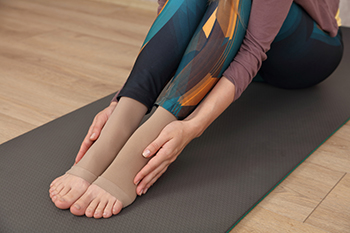Connect With Us
Blog
Items filtered by date: October 2023
The Seriousness of Foot Pain

Foot pain can be more than just an inconvenience, it can be a warning sign of underlying health issues. Various health conditions can manifest through foot pain. For instance, a malfunctioning thyroid gland can affect nerve sensation in your feet. Similarly, degenerative changes in your lower back could irritate spinal nerves, impacting foot health. Peripheral arterial disease, or PAD, results from plaque buildup in leg arteries, causing foot pain and increasing the risk of heart attack and stroke. Rheumatoid arthritis is another culprit that can result in foot and ankle symptoms and severely alter the shape of your feet over time. Additionally, gout results from uric acid buildup, causing intense foot pain. Diabetes can damage nerves and blood vessels in the feet, leading to numbness and infections. Ignoring foot pain can be perilous. Not only could it indicate a localized issue, but it may also be a symptom of more systemic health problems. Therefore, if you have chronic or severe foot pain, it is strongly suggested that you make an appointment with a podiatrist for a proper diagnosis and individualized treatment.
Foot Pain
Foot pain can be extremely painful and debilitating. If you have a foot pain, consult with David A. Edmonds, DPM from Advanced Podiatry Associates. Our doctor will assess your condition and provide you with quality foot and ankle treatment.
Causes
Foot pain is a very broad condition that could be caused by one or more ailments. The most common include:
- Bunions
- Hammertoes
- Plantar Fasciitis
- Bone Spurs
- Corns
- Tarsal Tunnel Syndrome
- Ingrown Toenails
- Arthritis (such as Gout, Rheumatoid, and Osteoarthritis)
- Flat Feet
- Injury (from stress fractures, broken toe, foot, ankle, Achilles tendon ruptures, and sprains)
- And more
Diagnosis
To figure out the cause of foot pain, podiatrists utilize several different methods. This can range from simple visual inspections and sensation tests to X-rays and MRI scans. Prior medical history, family medical history, and any recent physical traumatic events will all be taken into consideration for a proper diagnosis.
Treatment
Treatment depends upon the cause of the foot pain. Whether it is resting, staying off the foot, or having surgery; podiatrists have a number of treatment options available for foot pain.
If you have any questions, please feel free to contact our offices located in Northampton and Allentown, PA . We offer the newest diagnostic and treatment technologies for all your foot care needs.
Prevention of Athlete’s Foot

Athlete's foot, medically known as tinea pedis, is a common fungal infection that affects the skin of the feet, particularly between the toes. It's caused by various types of fungi, including trichophyton and epidermophyton, which thrive in warm, damp environments such as sweaty socks or tight shoes. Athlete's foot often starts with itching and burning sensations, followed by red, flaky, or scaly skin, and sometimes is accompanied by blisters and a foul odor. To prevent athlete's foot, it is important to maintain exceptional foot health. Wash and thoroughly dry your feet daily, ensuring the spaces between your toes are clean and dry. Changing socks frequently, especially after physical activities, can also help. Opt for breathable footwear and avoid walking barefoot in public areas like locker rooms or swimming pools. By incorporating these practices into your routine, you can combat and prevent athlete's foot, maintaining healthy and happy feet. If you have developed athlete’s foot, it is strongly suggested that you are under the care of a podiatrist who can prescribe the right course of treatment for you.
Athlete’s foot is an inconvenient condition that can be easily reduced with the proper treatment. If you have any concerns about your feet and ankles, contact David A. Edmonds, DPM from Advanced Podiatry Associates. Our doctor will treat your foot and ankle needs.
Athlete’s Foot: The Sole Story
Athlete's foot, also known as tinea pedis, can be an extremely contagious foot infection. It is commonly contracted in public changing areas and bathrooms, dormitory style living quarters, around locker rooms and public swimming pools, or anywhere your feet often come into contact with other people.
Solutions to Combat Athlete’s Foot
- Hydrate your feet by using lotion
- Exfoliate
- Buff off nails
- Use of anti-fungal products
- Examine your feet and visit your doctor if any suspicious blisters or cuts develop
Athlete’s foot can cause many irritating symptoms such as dry and flaking skin, itching, and redness. Some more severe symptoms can include bleeding and cracked skin, intense itching and burning, and even pain when walking. In the worst cases, Athlete’s foot can cause blistering as well. Speak to your podiatrist for a better understanding of the different causes of Athlete’s foot, as well as help in determining which treatment options are best for you.
If you have any questions please feel free to contact our offices located in Northampton and Allentown, PA . We offer the newest diagnostic and treatment technologies for all your foot and ankle needs.
Soccer Related Ankle Injuries

In soccer, ankle injuries are quite common. These injuries often affect the ligaments that hold the ankle joint together, which can change how the ankle works. The most common injury is a sprained ankle, and it is usually treated without surgery. Instead, the focus is on preventing future sprains and long term problems. Sometimes, repeated ankle injuries can lead to chronic ankle instability, where the ankle becomes less stable. Chronic ankle injuries, stress fractures, and high ankle sprains may need surgery to fix the ligaments and other issues. If you have sustained an ankle injury while playing soccer, it is suggested that you make an appointment with a podiatrist for proper care and treatment to prevent lingering ankle issues.
Sports related foot and ankle injuries require proper treatment before players can go back to their regular routines. For more information, contact David A. Edmonds, DPM of Advanced Podiatry Associates. Our doctor can provide the care you need to keep you pain-free and on your feet.
Sports Related Foot and Ankle Injuries
Foot and ankle injuries are a common occurrence when it comes to athletes of any sport. While many athletes dismiss the initial aches and pains, the truth is that ignoring potential foot and ankle injuries can lead to serious problems. As athletes continue to place pressure and strain the area further, a mild injury can turn into something as serious as a rupture and may lead to a permanent disability. There are many factors that contribute to sports related foot and ankle injuries, which include failure to warm up properly, not providing support or wearing bad footwear. Common injuries and conditions athletes face, including:
- Plantar Fasciitis
- Plantar Fasciosis
- Achilles Tendinitis
- Achilles Tendon Rupture
- Ankle Sprains
Sports related injuries are commonly treated using the RICE method. This includes rest, applying ice to the injured area, compression and elevating the ankle. More serious sprains and injuries may require surgery, which could include arthroscopic and reconstructive surgery. Rehabilitation and therapy may also be required in order to get any recovering athlete to become fully functional again. Any unusual aches and pains an athlete sustains must be evaluated by a licensed, reputable medical professional.
If you have any questions please feel free to contact our offices located in Northampton and Allentown, PA . We offer the newest diagnostic and treatment technologies for all your foot and ankle needs.
Magnetic Resonance Imaging for Peripheral Artery Disease

Peripheral artery disease, also known as PAD, is a common circulatory condition that primarily affects the arteries of the legs and feet. It occurs when fatty deposits build up in the arteries, causing them to narrow and reduce blood flow to the limbs. Symptoms of PAD include pain, cramping, and fatigue in the legs and feet, especially during physical activity. If severe, this condition can lead to pain at rest, non-healing wounds or ulcers, and tissue damage or gangrene. Treatment aims at relieving symptoms and preventing complications. While non-invasive imaging tests have been used to assess PAD, recent advancements in MRI techniques have had a significant impact on the diagnosis and understanding of this disease. If you are suffering from peripheral artery disease and have troublesome foot symptoms, it is strongly suggested that you make an appointment with a podiatrist to see if any of the newer advancements in testing can better pinpoint effective treatment for you.
Poor circulation is a serious condition and needs immediate medical attention. If you have any concerns with poor circulation in your feet contact David A. Edmonds, DPM of Advanced Podiatry Associates. Our doctor will treat your foot and ankle needs.
Poor Circulation in the Feet
Poor blood circulation in the feet and legs is can be caused by peripheral artery disease (PAD), which is the result of a buildup of plaque in the arteries.
Plaque buildup or atherosclerosis results from excess calcium and cholesterol in the bloodstream. This can restrict the amount of blood which can flow through the arteries. Poor blood circulation in the feet and legs are sometimes caused by inflammation in the blood vessels, known as vasculitis.
Causes
Lack of oxygen and oxygen from poor blood circulation restricts muscle growth and development. It can also cause:
- Muscle pain, stiffness, or weakness
- Numbness or cramping in the legs
- Skin discoloration
- Slower nail & hair growth
- Erectile dysfunction
Those who have diabetes or smoke are at greatest risk for poor circulation, as are those who are over 50. If you have poor circulation in the feet and legs it may be caused by PAD and is important to make changes to your lifestyle in order to reduce risk of getting a heart attack or stroke. Exercise and maintaining a healthy lifestyle will dramatically improve conditions.
As always, see a podiatrist as he or she will assist in finding a regimen that suits you. A podiatrist can also prescribe you any needed medication.
If you have any questions please feel free to contact our offices located in Northampton and Allentown, PA . We offer the newest diagnostic and treatment technologies for all your foot and ankle needs.
Compelling Reasons to Pursue Podiatry

Studying podiatry is a unique and rewarding journey that offers several compelling reasons to consider. Podiatrists play a vital role in healthcare by specializing in the diagnosis, treatment, and prevention of conditions related to the foot, ankle, and lower extremities. This specialization addresses a significant and often underestimated aspect of overall health. Additionally, podiatry offers diverse career opportunities. Graduates can work in various settings, including private practices, hospitals, sports medicine clinics, and research institutions. The ability to choose from different specialties within podiatry, such as sports medicine, surgery, or geriatrics, adds to the versatility of the field. Furthermore, the demand for podiatrists continues to grow as the population ages and becomes increasingly aware of the importance of foot health. Podiatry offers a stable and potentially lucrative career path. Ultimately, studying podiatry provides the chance to make a tangible difference in people's lives by improving their mobility, relieving pain, and enhancing their overall well-being. It is a profession that combines medical expertise with patient care, making it a fulfilling and impactful choice for those interested in healthcare. If you are interested in pursuing a career in podiatry, it is suggested that you discuss any questions or concerns with this type of doctor who can help you make an informed decision.
If you are experiencing pain in the feet or ankles, don’t join the stubborn majority refusing treatment. Feel free to contact David A. Edmonds, DPM from Advanced Podiatry Associates. Our doctor can provide the care you need to keep you pain-free and on your feet.
What Is a Podiatrist?
Someone would seek the care of a podiatrist if they have suffered a foot injury or have common foot ailments such as heal spurs, bunions, arch problems, deformities, ingrown toenails, corns, foot and ankle problems, etc.
Podiatric Treatment
A podiatrist will treat the problematic areas of the feet, ankle or lower leg by prescribing the following:
- Physical therapy
- Drugs
- Orthotic inserts or soles
- Surgery on lower extremity fractures
A common podiatric procedure a podiatrist will use is a scanner or force plate which will allow the podiatrist to know the designs of orthotics. Patients are then told to follow a series of tasks to complete the treatment. The computer will scan the foot a see which areas show weight distribution and pressure points. The podiatrist will read the analysis and then determine which treatment plans are available.
If you have any questions please feel free to contact our offices located in Northampton and Allentown, PA . We offer the newest diagnostic and treatment technologies for all your foot and ankle needs.
